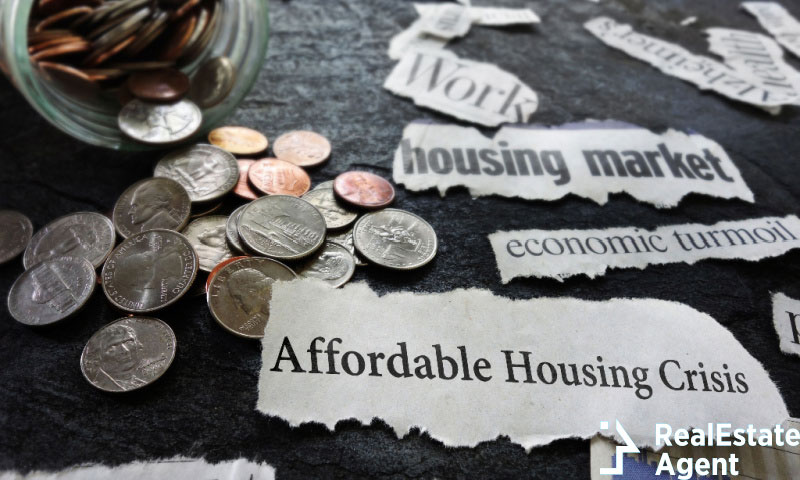Considering that we are dealing with a real estate market where an increasing amount of people find it impossible to purchase even the smallest and least appealing properties, it’s about time we take a closer look at what factors influence the current housing crisis. What we need to understand when analyzing these details is that we can not look at one factor and completely ignore the others that influence it.
The economy is a whole ecosystem that functions as a whole. Without being a living and breathing entity it moves, grows, develops, changes, and collapses as it is influenced by each factor that takes part in the economy. Understanding how the economy functions is something that investors study, analyze, and invest in in order to gain profit just like other influencing stakeholders within the economy.
However, the difference comes into play when one of the stakeholders of an economy has higher power than the others, unbalancing market sectors and creating inequality of opportunity.
Understanding the role these factors play in the housing crisis is a complex matter. This complexity comes from the complexity of the housing market itself and the level of power stakeholders acquire over time. When the economy goes through organic shifts, this power is spread among the stakeholders, but when the economy incurs external factors influencing it, this power is shifted towards a stakeholder or another. What becomes a problem is how some stakeholders can use this power for their own gain at the expense of others.
What Motivates Investors?
For any investor, the three main objectives that motivate their investments are safety, income, and growth. These objectives are the aim for investors but each objective is aimed at individually with investors picking the appropriate mix with one of them being their main focus. The purpose of a successful investor is to find the necessary balance between these objectives acknowledging that success at one objective comes at the detriment of the others. Understanding the “opportunity risk” of each investment is essential as investors balance the risk of each investment with the profit opportunity they can bring.
- Safety – relates to the risk associated with each investment. An investment opportunity that is safe brings modest returns compared to riskier investments.
- Income – relates to a focus on the revenue potential of the investment. These types of investments bring a steady income supply but a slightly increased risk.
- Growth – the investors aim to increase their capital and this can be managed only through selling assets. Capital growth investments can be achieved by buying assets when the price is low and selling when the price is high.
Real Estate Investor Impact
Housing affordability is under pressure due to a number of historical factors that influence supply, demand, and investment opportunities within the real estate market. With the current generational shift, growing demand and widespread shortage of housing resulting from decades of insufficient new housing being built, the real estate market is booming above the affordability of average home buyers. The pandemic era came with increased demand for housing but was faced with the supply result of decades of underbuilding. Currently, the US is facing a 6.8 million deficit in housing according to the National Association of Realtors, driving housing prices to record-breaking highs.
The impact real estate investors have comes from how they act based on their analysis of the market at any given time and speculating on how and in which way the changes will occur. During this analysis, they look at assets based on numbers and level of interest in the market. For instance, stock investors buy when Elon Musk praises a new product and sell when the interest in the new product dips. With housing, they buy when the interest in the market for housing is low (cheap) and sell when the interest is high (expensive).
Wall Street Opportunities
Since the housing crash of 2008, Wall Street firms expanded their profit by buying cheap and selling overpriced. That trend has been going on for over a decade with investment firms buying after the financial crisis, betting on the collapse of the market as that made it easier for them to invest and flip properties for a profit when demand started up again. Another trend was to transform homes into rentals for a steady return.
While this was a natural flow in the market during the post-Great Recession period, the pandemic sprinkled adrenaline on it resulting in the fastest housing inflation since 1987. In 2010, real estate investors made up a little over 8% of the real estate purchased, but by 2021 we saw an increase by 10%, their share of purchased properties reaching 18%. Furthermore, 74% of the properties purchased by real estate investors are single-family homes, with a focus on low-priced properties and location. This leads to a battle between real estate investors and regular home buyers.
Investors Upper Hand
When it comes to housing affordability and accessibility the playing field is biased towards investors. Seeing as over the last year, the percentage of homes bought by investors rose to 18%, regular homebuyers are struggling. We can first understand that successful real estate investors have a growing capital that can be further invested in more opportunities. Secondly, due to their capital, large corporate investors have easier access to financing options being allowed to use property they already own as collateral. Lastly, they even pay less in full-cash payments.
While the biggest percentage of regular homebuyers are Millennials, their ability to save money due to the expenses related to living in 2022 is incredibly low with less than 15% capable of saving up more than $10,000 for a downpayment. Investors on the other hand can make purchases in full, with higher down payments or for a lower price due to the trust sellers have in those that take out the big bucks. An analysis done by the University of Wisconsin proved that investors paid on average 10% less than individual buyers for comparable properties. With cash available, they have higher negotiating power and are getting a better price. When they, in turn, sell or rent, they control enough of the available market that they can dictate the prices.
Investors vs. First-Time Buyers
Chief economist for the National Association of Realtors concluded that the percentage of homes purchased by investors climbed by 10% by January 2021, and further rose to 22% by January 2022. In comparison, home sales that went to first-time buyers were at 33% in January 2021 and fell to 27% by this year. If the real estate market would be equilibrated, first-time buyers would account for around 40% of the home sales.
Historically low housing inventory pushes housing prices higher, increases bidding wars, and opportunities for wealthy individuals but is a nightmare for those needing to limit their investments to 30% of their monthly income. Down payments reached an average of 27% of the home price in January 2022, from 19% the previous year. Sellers would much rather get cash offers than mortgage buyers leaving first-time buyers with no alternative or equal opportunities in the housing market seeing as most of them purchase property through mortgages and can barely reach the 20% down payment requirement.
The housing market has developed into the most powerful and consequential way to build wealth in America over the past decades. Investors aim for their profits while creating an impossible market for first-time buyers completely eradicating the American Dream.
Supply and Demand Imbalance
The effect of the housing market crash and the resulting financial crisis of 2008 had on homebuilding did not completely recover to this day. If the US economy is to supply sufficient housing for the annual demand, an average of 1.5 million homes should be built yearly. However, the US housing market has fallen behind the average annual necessary for over a decade. The home construction decline led to an immense supply shortage for housing that can be purchased or rented.
Looking at historical data provided by TracingEconomics[dot]com, we can see that in the housing construction industry rates climbed and fell at various intervals since the 1960s. I considered we should go way back to truly understand this issue. Firstly, we’ll cover the averages, or the periods when the housing market was considered stable. In the early to mid-1960s around 1.5 million homes were being built. In 1968 the average was there as well. With rises and drops, we can see that changes always occur around that margin. Some rises are more accelerated and climb higher and some happen with drops, but the market goes back to the average of 1.5 million homes built every 5 to 7 years. There was a softer drop at the end of the 1980s and the resulting climb was spread over a span of 10 years starting in 1990. That climb lasted over 15 years which brings us to 2006 when the housing market crashed leading to global effects on the world’s population.
What happens after 2006 is the drop and after a climb of 10 years, the drop lasts for 2. This drop goes from over 2 million homes built during 2006 to 500,000 built in 2008. Subsequently, the climb started during 2009 and 2010, but the annual rate of new homes built was much steadier, only managing to reach the average of 1.5 million in 2020 when it dropped again below 1 million due to the pandemic. Since then the home building rates only reached 1.7 million after over two decades of steady but slow growth that did not make up for the shortages accumulated from the 10-year drop till now.
If you take into account the population distribution by generation, a graph provided by Statista[dot]com showcases that Millennials (26-41 years old – born between 1981-1996) are the biggest population group in the country, reaching 21.93%. The second group is the Baby Boomers (58-76 – born between 1946-1964) encompassing 21.45% of the population. Third, in the row is Generation Z (10-25 years old – born between 1997-2012) with 20.35% of the population. The millennial generation is at average house purchasing age right now, but half of Gen Z is also there. However, what is happening is that many belonging to these two generations can barely afford to rent. As we go into the next section, keep in mind that Millennials are between 26-41 at house purchasing age, but we’ll see in a bit, that age came sooner for Baby Boomers.
Generational Affordability
Based on what we have seen above, we can look further and understand the financial opportunities based on these generations and see their expected housing expenses. In 2015, the Millennial generation had a median household income of $105,000 (bachelor’s degree or higher), $62,000 (some college), and $49,000 (high school). During the same period, Baby Boomers had a median household income of $90,000 (bachelor’s degree or higher), $63,000 (some college), and $52,000 (high school).
To go even further and compare what people of a certain age group earned regarding the historical evolution of the economy we can see that the median household income for those of home-buying age in 2020 rounded up to $86,000, while in 1985 the home-buying generation received an income of $71,000. This is what both generations (Millennials and Baby Boomers) earned during the peak age of employment in the respective years they started looking into purchasing their first property. For Baby Boomers that was at 25, while for Millennials it is closer to 30.
Now, let’s look at the housing expenses these groups of people encountered when they looked into purchasing real estate. The median housing price in the US real estate market in March of 2022 was $374,000 with Millennials being the biggest demographic group in search of purchasing their first real estate property. The timeline for Baby Boomers to purchase their first home was 1985 when the median US housing price was $70,000.
Baby Boomers had to pay on average $70,000 to buy their home from an annual household income of $71,000, while Millennials are dealing with median annual incomes of $86,000 but have to pay $374,000 for their home. The final comparison is inflation which was at 3.6% on average in 1985 while so far in 2022 has been climbing from 7.5% to 8.6%. Furthermore, inflation affected housing by 6.9% in 2022 climbing from 4.6% in 2021, but in 1985 it was at 2.9%.
In conclusion
The current state of the real estate market is only profitable and affordable for investors or high-income earners. However, the biggest demographic of homebuyers don’t control enough wealth and are not a part of the high-income earners, making it increasingly difficult for them to purchase a property. The housing market is disproportionately skewed to the detriment of home buyers’ affordability with new multi-family constructions being near historic lows. Lastly, the annual housing figures show the discrepancy between the 1,126,000 single-family homes and 12,000 multi-family homes built in 2021, leaving only 460,000 for buildings with more than 5 units, with a majority of single-family homes being bought by investors.
Based on this analysis, the role investors play in the real estate market carries a heavy punch in the case of the housing crisis we are currently facing. While buying a home is the dream most Americans grew up with, the reality is stripping away this dream and without some form of intervention or moral compass, the younger generations are left struggling to meet their needs in today’s economy.















